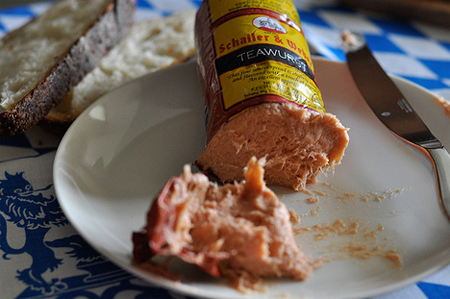Food server, is there transglutaminase in that steak I just ordered?
That’s what the American Meat Institute says concerned consumers at the restaurant or some big banquet where they’re serving up lots of steaks.
I ask servers what rare and medium mean. They mutter. I ask them about thermometers. They dream about someone with far away eyes.
Tales of transglutaminase, also known in the growing meat slang as meat glue, have been circulating on the Internet for years.
In March 2011, an Australian TV tabloid show called Today Tonight did what they called an exclusive expose on  meat glue, where cheap cuts of meat were allegedly glued together and shaped to look like a fillet mignon.
meat glue, where cheap cuts of meat were allegedly glued together and shaped to look like a fillet mignon.
Last week, ABC7 San Francisco, proclaimed they had “uncovered another meat industry practice that will have you looking twice at the meat you eat.”
Maybe ABC7 discovered the Internet, or watched tape (Beta) from Australia.
The San Fran folks did find a meat company owner, who wouldn’t go on camera, saying gluing meat is common practice in the industry and the most glued product by far is filet mignon destined for the food service industry.
ABC7 says it confirmed this with an industry trade group that meat glue is common where filet mignon is served in bulk — at a restaurant, banquet, cafeteria or hotel.
The problem is the outside of a piece of meat comes in contact with a lot of bacteria making its way from slaughterhouse to table. Usually cooking a steak on the outside will kill all that off. The center of a single cut of steak is sterile, that’s why you can eat it rare. But glue pieces of meat together and now bacteria like E. coli could be on the inside.
In the U.S., such an additive has to be labeled at retail – in really, really tiny print that I can’t read, even with my old-man glasses – but what about at a restaurant or a banquet hall?
"You bring up a valid point, and you know they may not see the label, but what they ought to do if they have concerns, and we understand that consumers, they want to understand where there food is coming from, they should ask their wait staff," says Dr. Betsy Booren of the American Meat Institute.
Janet Riley, a spokeswoman for the American Meat Institute told msnbc.com, “There’s just no way that gluing chunks of chuck meat together is going to give you filet mignon.”
It likely wouldn’t make economic sense for restaurants to go to the time and trouble to stick together scraps of meat, given the cost of the transglutaminase, which runs about $40 a pound wholesale, much more than any stew meat they might use.
“I don’t know where that would be happening; it would be a very expensive thing to do,” said Randall K. Phebus, an associate professor of animal sciences and industry at Kansas State University who specializes in food safety.

 percent free−range by 2020.
percent free−range by 2020. strain isolated in the suspected food was performed as well as a traceability investigation.
strain isolated in the suspected food was performed as well as a traceability investigation.
 been reported in Chinese journals.”
been reported in Chinese journals.” contributing factors to the massive outbreak. However, increased transmission would have expected to increase number of infections but not higher number of HUS rate and high mortality rate. Host factors may contribute to higher mortality with a disproportional number of HUS cases and deaths in the older age groups. We showed that the outbreak was caused by a new sequence type, ST96.”
contributing factors to the massive outbreak. However, increased transmission would have expected to increase number of infections but not higher number of HUS rate and high mortality rate. Host factors may contribute to higher mortality with a disproportional number of HUS cases and deaths in the older age groups. We showed that the outbreak was caused by a new sequence type, ST96.”
 which is fermented but not heat-treated. The producer of the teewurst had received pork from slaughterhouse A during the period that the outbreak strain had been isolated.
which is fermented but not heat-treated. The producer of the teewurst had received pork from slaughterhouse A during the period that the outbreak strain had been isolated. system across the EU, with detailed product and distribution information, for tracing products might prove worthwhile.
system across the EU, with detailed product and distribution information, for tracing products might prove worthwhile. the previously unknown group Farmers’ Peace Corps kidnapped the 31 sheep slated for slaughter, leaving a note that read:
the previously unknown group Farmers’ Peace Corps kidnapped the 31 sheep slated for slaughter, leaving a note that read:.gif) premises that receive them will be subject to a quarantine and further regulatory action.
premises that receive them will be subject to a quarantine and further regulatory action.

 affected, 491 hospitalizations, and seven deaths; and Chinese, Indian, British and Italian cuisines were the most commonly implicated (26%, 16%, 13% and 10%, respectively).
affected, 491 hospitalizations, and seven deaths; and Chinese, Indian, British and Italian cuisines were the most commonly implicated (26%, 16%, 13% and 10%, respectively). .jpg) evidence of food control failures can be used to target foodborne illness reduction strategies.
evidence of food control failures can be used to target foodborne illness reduction strategies.